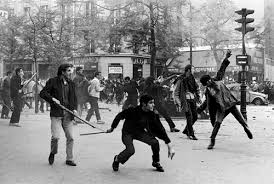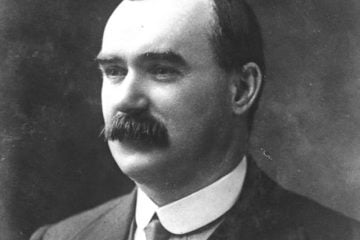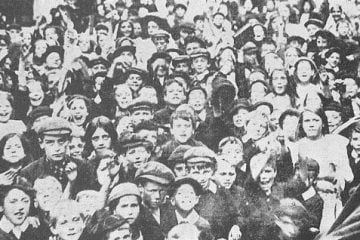To mark the publication of Marxism and Anarchism, we publish below a review of this text by Archie Marshall, President of the LSEsu Marxist Society and member of the MSF Executive Committee.
——————————–
 The 2008 economic collapse had a radicalizing effect on students and young workers, who are always the first to respond to these earth-shaking events. In the face of all this, however, the politicians who purport to represent the working class (Labour in England and the mass ‘socialist’ and Stalinist parties throughout Europe) have only collaborated in the crimes against working people everywhere. It is only natural that in reaction to this betrayal, the awakened youth has developed a distaste for political organization, and have turned to the seemingly novel ideas of anarchists like Noam Chomsky, Michael Albert, and David Graeber. In reality these ideas are far from new, dating back to the struggle between Marx and Bakunin in the First International. If we seriously want to overthrow capitalism and build a socialist society, we must study the theoretical, tactical, and historical aspects of this debate. It is in this spirit that this collection, Marxism and Anarchism, was put together: to educate a new generation of revolutionaries in the best and most effective traditions of the working class movement.
The 2008 economic collapse had a radicalizing effect on students and young workers, who are always the first to respond to these earth-shaking events. In the face of all this, however, the politicians who purport to represent the working class (Labour in England and the mass ‘socialist’ and Stalinist parties throughout Europe) have only collaborated in the crimes against working people everywhere. It is only natural that in reaction to this betrayal, the awakened youth has developed a distaste for political organization, and have turned to the seemingly novel ideas of anarchists like Noam Chomsky, Michael Albert, and David Graeber. In reality these ideas are far from new, dating back to the struggle between Marx and Bakunin in the First International. If we seriously want to overthrow capitalism and build a socialist society, we must study the theoretical, tactical, and historical aspects of this debate. It is in this spirit that this collection, Marxism and Anarchism, was put together: to educate a new generation of revolutionaries in the best and most effective traditions of the working class movement.
Utopia or science? The philosophical foundations of Marxism and anarchism
“The utopian is one who, starting from an abstract principle, seeks for a perfect social organization.” [1]
Although this volume includes 22 articles by a dozen authors, for reasons of space and relevance we will focus on only some of these. Immediately we are struck by G.V. Plekhanov’s 1895 article Anarchism and Socialism, which explores the theoretical origins of anarchism, tracing them back to the utopian socialism of the 18th and early 19th centuries. The utopian socialists, following the lead of the bourgeois political theorists who preceded them, saught to find the “perfect legislation” for human society. In practice, out of their own imagination they pulled model after model of the ideal society, the social organization that would be most harmonious with “human nature.” While the apologists of capitalism defined (and still define) the nature of humanity as realized in bourgeois property and free trade, the utopian socialists turned this argument on its head and created a new “human nature,” this time favoring collective property and altruism. While this new “socialist nature” was just as invented as the old capitalist one, it nevertheless represented a great advance: the first theoretical formulation of socialism, as a justification for the new collective struggle that was being waged by the newly formed proletariat.
In the middle of the 19th century, there was the massive advance from utopian socialism to scientific socialism, i.e. Marxism. Marx and Engels noted that the “human essence,” the “nature” of people in society, depended wholly on the mode of organization of that given society. Thus, in capitalist society, where people relate to each other through the exchange of privately possessed commodities, this ‘nature’ is marked by individual “freedom, property, equality and Bentham” [2], but this cannot be said of feudal society, slave society, less still the primitive communism of early humans. Furthermore, Marx and Engels showed how social change through history resulted from the growth of science and technology (the forces of production), of humanity’s domination over nature, and that the organization of society around this technology (the relations of production) resulted in opposing class divisions, between exploiter and exploited, whose contradictory struggle repeatedly revolutionized society. They showed that socialism is not just “a good idea,” but the concrete struggle of the working class within capitalism which, accumulating pressure in irresolvable contradictions, becomes revolutionary.
The systematic development of Marxism largely emerged in opposition to the utopian socialists. The strongest current of utopian socialism back then (and still today) is represented by anarchism, which Plekhanov masterfully traces from its origins in Stirner and Proudhon to Bakunin and Kropotkin. We lack the space to expound their theories here, but in the pages of Marxism and Anarchism readers will see that they were idealists, basing social change on movements of the mind. This outlook is the opposite of Marxism—materialism—which brings socialism away from the misty peaks of the imagination, down to earth, to the concrete revolutionary struggle of the working class. It is the antithesis of the long utopian thread extending through anarchism all the way up to its contemporary exponents, such as Michael Albert, whose utopia of “ParEcon” (participatory economics) is critiqued in another article of this volume.
From “propaganda of the deed” to “direct action”
From utopian and middle class ideology, we can directly trace the utopian and middle class tactics of anarchists from the 19th to the 21st century. Setting out from a materialist understanding of society, Marx and Engels developed a science of revolution that saw the agency of classes and groups as fundamental for change, while taking into account the objective conditions within which these groups were forced to work. They agreed with the anarchists, for example, that the state is an oppressive instrument to be thrown into the museum of prehistory. But unlike anarchists, they did not set out from abstract principles, and understood that the state exists because of material necessity—the existence of classes—and that the proletariat had to construct its own democratic workers’ state which would whither away with the advent of classless society. Furthermore, because of its position within capitalism, it was only the collective, organized working class that could bring revolutionary change.
Similarly, we recognize that if we are to destroy the centralized tyrant that is bourgeois society, we need a democratic but centralized organization of the working class. This was one of the major struggles waged by Marx and Engels in the First International against Bakunin, who thought members of the revolutionary organization shouldn’t be constrained by collective democratic decisions. This is a fundamentally middle class tactic, as Alan Woods writes in the included article Marx versus Bakunin:
“The middle classes are used to individualistic methods and have an individualistic mentality. An assembly of students can debate for hours, days and weeks without ever coming to a conclusion. They have plenty of time and are accustomed to that kind of thing. But a factory mass meeting is an entirely different affair. Before a strike, the workers discuss, debate, listen to different opinions. But at the end of the day, the issue must be decided. It is put to the vote and the majority decides. This is clear and obvious to any worker.” [3]
The anarchists, ignoring material conditions, believed that revolution and socialism could simply be made to fall out of the sky. Bakunin thought that “the people” could be roused to revolt through violent acts of individual terrorism on the part of a conspiratorial sect. Although this idea, the “propaganda of the deed,” is unfashionable among modern anarchists, their tactics still rest on the same petty bourgeois and idealist fundamentals. The modern fad is “direct action” or “prefigurative politics”—acting as if we were already free. The theorists of prefigurative politics believe that by “placing ourselves outside of capitalism” (for example, by exchanging without money, forming horizontal organizations, eating from our own organic garden and so on) we pose a threat to the system. They think that by ignoring capitalism and bourgeois state power, we can make capitalism crumble upon itself. In reality, simply ignoring state power couldn’t make Cameron and the bosses any happier. The history of the class struggle clearly shows that the victory of the workers is dependent on whether they set out to conquer power.
The testing grounds of history
The last section of this volume comprises historical works on anarchist movements throughout history, including Nestor Makhno’s black army during the Russian Revolution, the suppression of the Kronstadt revolt, and the CNT in the Spanish revolution. These experiences prove the accuracy of the Marxist theory of the role of classes, as well as the question of power.
Far from being based on anarchist ideological principles, Makhno was successful by basing himself on the interests of the peasantry, which, as Marx explained 100 years ago, always play a vacillating role between the bourgeoisie and the proletariat. In the fight against the Germans and the White reaction—which aimed to restore power to the feudal landlords—Makhno and the peasants fought to defend their own property interests. At a time when three quarters of his forces were poor peasants, he could only maintain his support by allying with the Red Army. But with the defeat of the White forces, and the removal of the feudal threat, in the 1920s the contradictions within the villages came to the fore, making Makhno lose his base of support. Increasingly, his army was composed of rich peasants, Kulaks, who were only interested in a free market for grain. He based his power entirely on tailing these Kulaks, and this can be seen from his breaking of anarchist principles, from appointing all higher officials himself and to creating a brutal secret police. Nabat, the confederation of Ukrainian anarchist groups, recognized that Makhno was no longer an anarchist. The opportunism of Makhno was a result of his peasant base of support, which without the leadership of the working class cannot play a progressive revolutionary role.
In other essays in Marxism and Anarchism we see that anarchism plays an anti-revolutionary role even when it bases itself on the revolutionary proletariat. In the Spanish revolution, the anarchist leaders of the CNT refused any kind of political struggle, basing themselves entirely on their own trade unions. On multiple occasions (July 1937, May 1937) the revolutionary working class could have taken power, but instead of calling for the formation of soviets (democratic workers’ councils) the CNT held back under the belief that all power corrupts. Trotsky outlines this issue with anarchist theory and tactics:
“To renounce the conquest of power means voluntarily to leave the power with those who have it, i.e. the exploiters. The essence of every revolution consisted and consists in the fact that it puts a new class in power and thus gives it the opportunity to realize its own program. It is impossible to lead the masses toward insurrection without preparing for the conquest of power. No one could have hindered the Anarchists after the conquest of power from establishing such a regime as they consider necessary.” [4]
Ironically, the anarcho-syndicalists ended up participating in the popular front government alongside the bourgeois parties and the Stalinists. It is a constantly recurring theme that the workers’ organizations that renounce power when it is in their hands, become disillusioned with their tactics and immediately drift to the right, turning into reformists.
All of this is only an outline, and can’t do justice to the content of Marxism and Anarchism. Readers will find classic works by Engels, Lenin, Trotsky, and Plekhanov, but also modern writings such as A. Kramer’s articles on Makhno and Kronstadt, which rely on recently uncovered historical data. A rich and varied collection, the book is a guide for militants in the student and labor movements—to be consulted and reconsulted.
by Archie Marshall, LSEsu Marxists
References
-
G.V. Plekhanov, Anarchism or Socialism. In Marxism and Anarchism, pp. 20
-
Karl Marx, Capital Vol. 1, pp. 280
-
Alan Woods, Marx versus Bakunin. In Marxism and Anarchism, pp. 90
-
Leon Trotsky, The Lessons of Spain – the Last Warning. In Marxism and Anarchism, pp. 314



